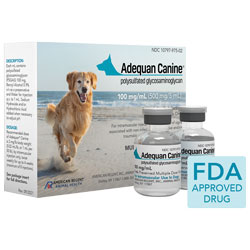Adequan Canine
Free Shipping on orders over $75
Low Price Match Guarantee
- PSGAG (Polysulfated Glycosaminoglycan) Sterile Injection
- For intramuscular injection
- For the control of signs associated with non-infectious degenerative and/or traumatic arthritis of canine synovial joints
- 100mg/ml (500mg per bottle) - 5ml vial
Description
Adequan® Canine (polysulfated gylcosaminogylcan) is an FDA-approved disease-modifying osteoarthritis drug (DMOAD) that inhibits cartilage loss in dog's joints, and may help to:- Restore joint lubrication
- Relieve inflammation
- Renew the building blocks oh healthy cartilage
How does it work?
It is administered two
times a week for four weeks, the drug is injected intramuscularly to
ensure it reaches the critical parts of the joint. It goes to work in
the joint in about two hours and stays in the joint for about three
days. With Adequan® Canine you should see signs of improvement within
four weeks. Your dog may begin to act like the playful, active dog you
remember.
Cautions
Adequan Canine should be used with caution in dogs with renal or hepatic impairment. Possible side effects (pain at injection site, diarrhea and abnormal bleeding) were mild, transient and self-limiting. Safety studies of PSGAG in breeding, pregnant or lactating dogs have not been conducted.
Know how to spot the early signs of arthritis and the risk factors
- Observe your dog for signs of arthritis
- Tell your vet about signs you’ve observed and/or your dog’s behavior changes
- Follow your veterinarian’s treatment protocol
- Ask for Adequan® Canine to slow the disease of arthritis
- Take steps to maintain good joint health
- Keep your veterinarian updated on your dog’s progress
- Talk to your veterinarian about other ways to maintain good joint health
Storage
Store at 20° to 25°C (68° to 77°F) excursions permitted to 15° to 30°C (59° to 86°F) (See USP Controlled Room Temperature). Avoid prolonged exposure to temperatures ≥40°C (104°F).
Use within 28 days of first puncture and puncture a maximum of 10 times. Dispose of spent needles in accordance with all federal, state and local environmental laws.
Contraindications
Do not use in dogs showing hypersensitivity to PSGAG. PSGAG is a synthetic heparinoid; do not use in dogs with known or suspected bleeding disorders.
Precautions
The safe use of Adequan® Canine used in breeding, pregnant, or lactating dogs has not been evaluated. Use with caution in dogs with renal or hepatic impairment.
Adverse Reactions
In the clinical efficacy trial, 24 dogs were treated with Adequan® Canine twice weekly for 4 weeks. Possible adverse reactions were reported after 2.1% of the injections. These included transient pain at the injection site (1 incident), transient diarrhea (1 incident each in 2 dogs), and abnormal bleeding (1 incident). These effects were mild and self-limiting and did not require interruption of therapy.
Post Approval Experience (2014)
The following adverse events are based on voluntary, post-approval reporting. Not all adverse reactions are reported to FDA/CVM. It is not always possible to reliably estimate the adverse event frequency or establish a causal relationship to product exposure using these data. The signs reported are listed in decreasing order of reporting frequency.
- Vomiting
- Anorexia
- Depression/lethargy
- Diarrhea.
- In some cases, death has been reported
To report suspected adverse drug events, contact Luitpold Pharmaceuticals, Inc. at 1-800- 458-0163. For additional information about adverse drug experience reporting for animal drugs, contact FDA at 1-888-FDA-VETS or http://www.fda.gov/AnimalVeterinary/SafetyHealth.
Warnings
Not for use in humans. Keep this and all medications out of reach of children.
Efficacy
Efficacy of Adequan® Canine was demonstrated in two studies. A laboratory study using radiolabeled PSGAG established distribution of PSGAG into canine serum and synovial fluid following a single intramuscular injection of 2 mg/lb. A clinical field trial was conducted in dogs diagnosed with radiographically-confirmed traumatic and/or degenerative joint disease of 1 or 2 joints. Joints evaluated included hips, stifles, shoulders, hocks and elbows. Fifty-one dogs were randomly assigned to receive either Adequan® Canine at 2 mg/lb of body weight or 0.9% saline.
Both treatments were administered by intramuscular injection twice weekly for 4 weeks (8 injections total). Investigators administering treatment and evaluating the dogs were unaware of the treatment assignment. A total of 71 limbs in 51 dogs were evaluated. Of these, 35 limbs in 24 dogs were in the Adequan® Canine treated group. Each lame limb was scored for lameness at a walk, lameness at a trot, pain, range of motion, and functional disability. The scores for the individual parameters were combined to determine a total orthopedic score. At the end of the treatment period, dogs treated with Adequan® Canine showed a statistically significant improvement in range of motion and total orthopedic score over placebo treated control dogs.
Toxicity
In a subacute toxicity study, 32 adult beagle dogs (4 males and 4 females per treatment group) received either 0.9% saline solution or PSGAG at a dose of 5 mg, 15 mg, or 50 mg per kg of body weight (approximately 2.3, 6.8, or 22.7 mg/lb), via intramuscular injection twice weekly for13 weeks. PSGAG doses represent approximately 1X, 3X, and 10X the recommended dosage of2 mg/lb, and more than 3 times the recommended 4-week duration of treatment. Necropsies were performed 24 hours after the final treatment. During week 12, one dog in the 50 mg/kg dosage group developed a large hematoma at the injection site which necessitated euthanasia. No other mortalities occurred during the treatment period. Statistically significant changes in the 50 mg/kg group included increased prothrombin time, reduced platelet count, an increase in ALT and cholesterol, and increased liver and kidney weights. Increased cholesterol and kidney weights were also noted in the 15 mg/kg group. Microscopic lesions were noted in the liver (Kupffer cells containing eosinophilic foamy cytoplasm), kidneys (swollen, foamy cells in the proximal convoluted tubules), and lymph nodes (macrophages with eosinophilic foamy cytoplasm) in the15 mg/kg and 50 mg/kg groups. Intramuscular inflammation, hemorrhage, and degeneration were seen in all 3 PSGAG treated groups; the incidence and severity appeared dose related.
Pharmacology
The specific mechanism of action of Adequan® in canine joints is not known. PSGAG is characterized as a “disease modifying osteoarthritis drug”. Experiments conducted invitro have shown PSGAG to inhibit certain catabolic enzymes which have increased activity in inflamed joints, and to enhance the activity of some anabolic enzymes. For example, PSGAG has been shown to significantly inhibit serine proteinases. Serine proteinases have been demonstrated to play a role in the Interleukin-l mediated degradation of cartilage proteoglycans and collagen. PSGAG is reported to be an inhibitor of Prostaglandin E2 (PGE2) synthesis. PGE2has been shown to increase the loss of proteoglycan from cartilage. PSGAG has been reported to inhibit some catabolic enzymes such as elastase, stromelysin, metalloproteases, cathepsin B1,and hyaluronidases, which degrade collagen, proteoglycans, and hyaluronic acid in degenerative joint disease. Anabolic effects studied include ability to stimulate the synthesis of protein, collagen, proteoglycans, and hyaluronic acid in various cells and tissues invitro. Cultured human and rabbit chondrocytes have shown increased synthesis of proteoglycan and hyaluronic acid in the presence of PSGAG. PSGAGs have shown a specific potentiating effect on hyaluronic acid synthesis by synovial membrane cells in vitro.
Absorption, distribution, metabolism, and excretion of PSGAG following intramuscular injection have been studied in several species, including rats, rabbits, humans, horses and dogs.
Studies in rabbits showed maximum blood concentrations of PSGAG following IM injection were reached between 20 to 40 minutes following injection, and that the drug was distributed to all tissues studied, including articular cartilage, synovial fluid, adrenals, thyroid, peritoneal fluid, lungs, eyes, spinal cord, kidneys, brain, liver, spleen, bone marrow, skin, and heart.
Following intramuscular injection of PSGAG in humans, the drug was found to be bound to serum proteins. PSGAG binds to both albumin and chi and beta-globulins and the extent of the binding is suggested to be 30 to 40%. Therefore, the drug may be present in both bound and free form in the bloodstream. Because of its relatively low molecular weight, the synovial membrane is not a significant barrier to distribution of PSGAG from the bloodstream to the synovial fluid. Distribution from the synovial fluid to the cartilage takes place by diffusion. In the articular cartilage the drug is deposited into the cartilage matrix.
Serum and synovial fluid distribution curves of PSGAG have been studied in dogs and appear similar to those found in humans and rabbits.
In rabbits, metabolism of PSGAG is reported to take place in the liver, spleen, and bone marrow. Metabolism may also occur in the kidneys. PSGAG administered intramuscularly and not protein bound or bound to other tissues is excreted primarily via the kidneys, with a small proportion excreted in the feces.






